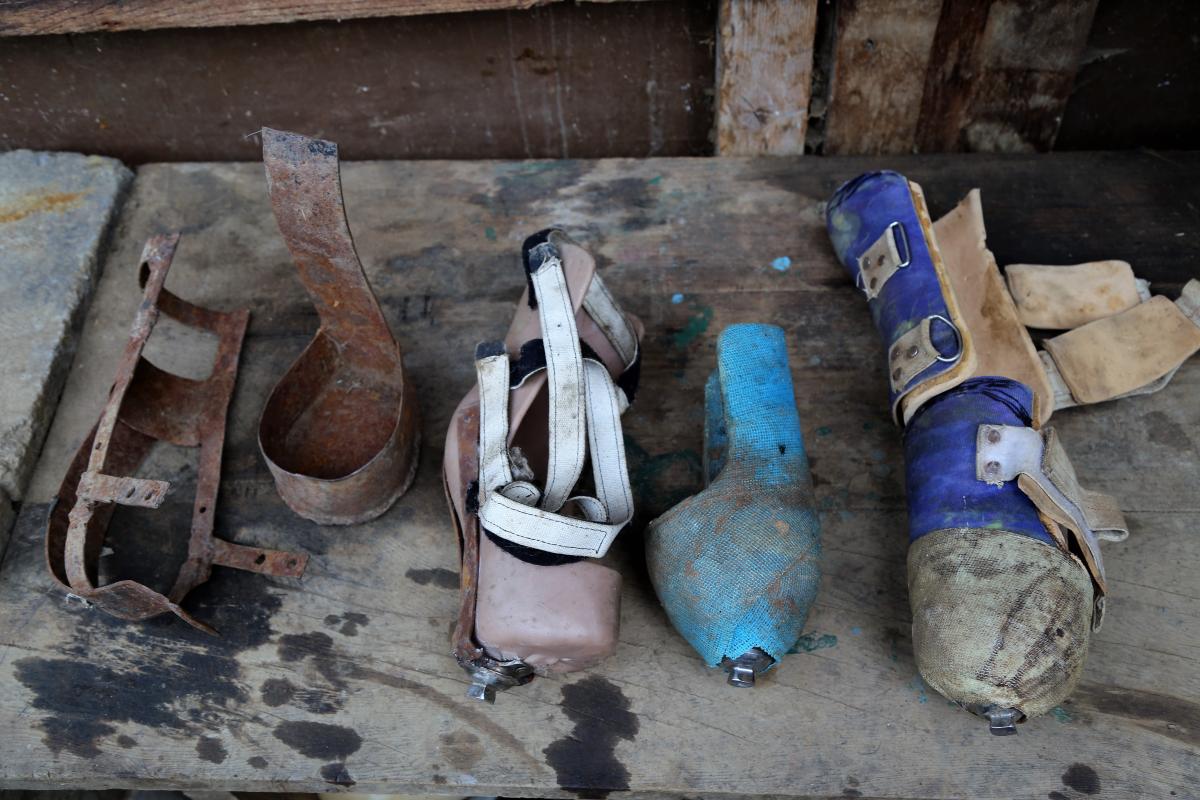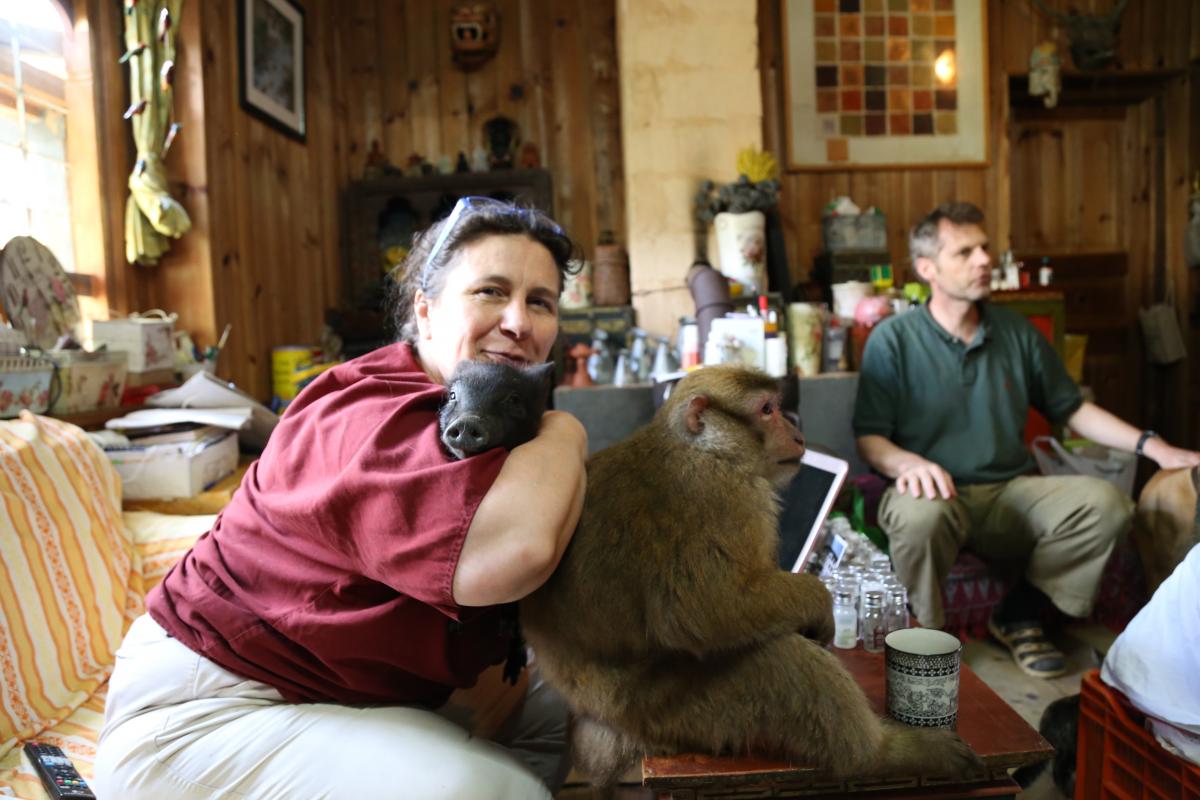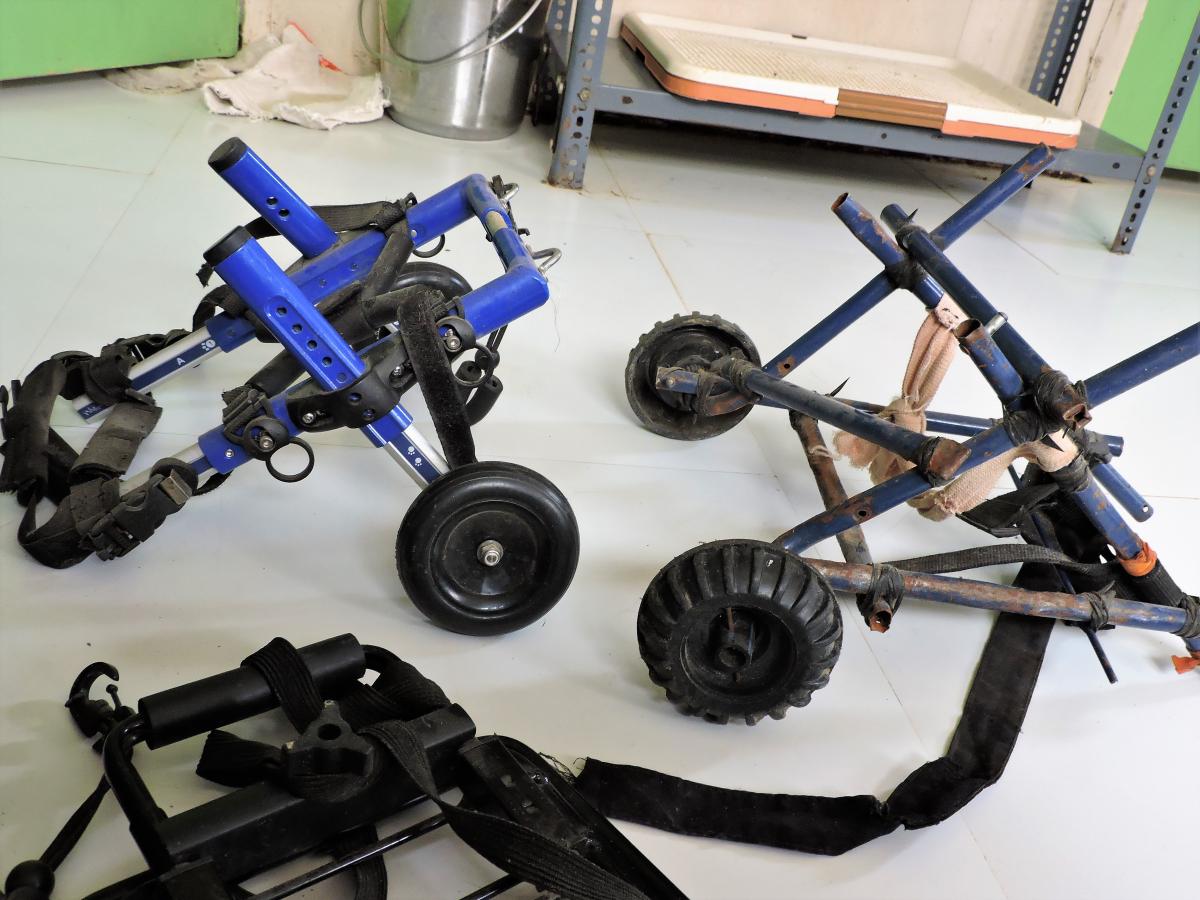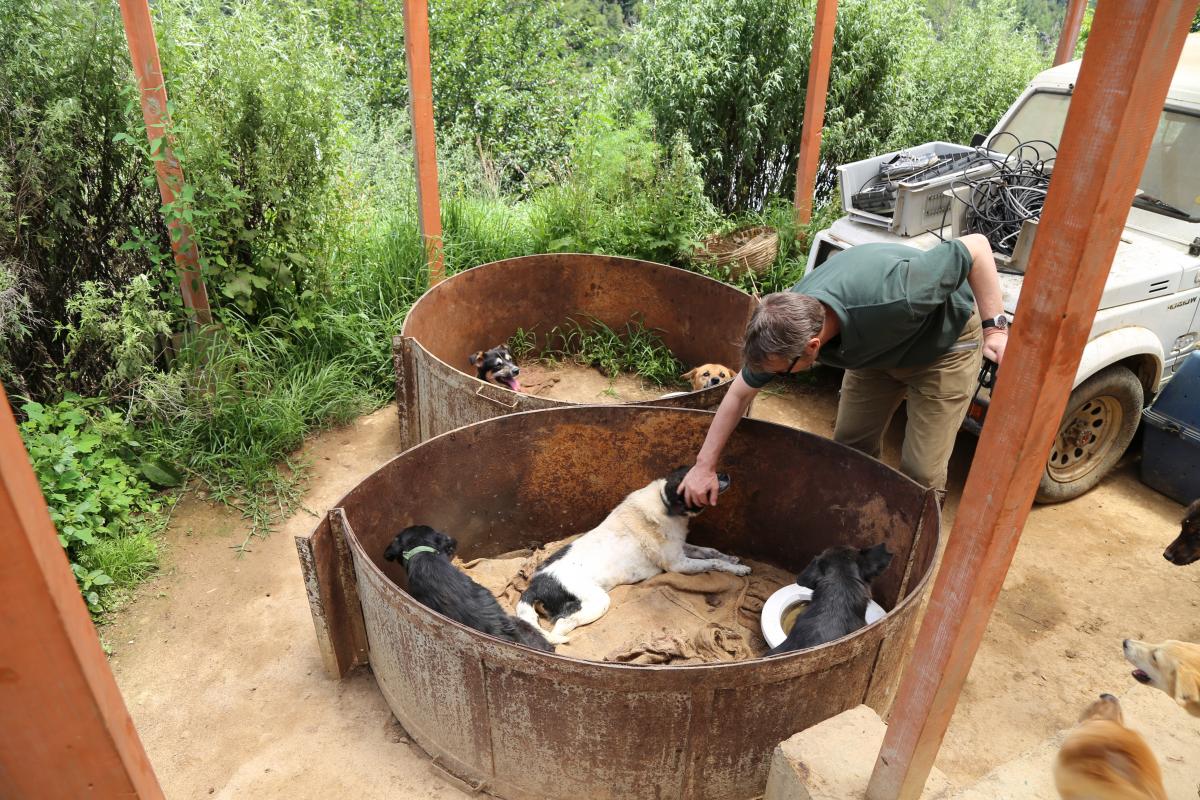Improvised Animal Hospital
In a country where medical supplies are scarce for humans, let alone animals, two self-trained veterinarians are using whatever they can find to build the materials they need to treat the animals they take care of.
Cover Photo: Besa the mule wearing one of the more than 50 homemade prosthetic prototypes that Jamie Vaughan has built using PVC pipe, metal, foam, duct tape and an automobile shock absorber. (Photo: Jessica Vernon)
In the master bathroom stands Tsem, a four-month-old foal with long, knobby legs, a fuzzy brown body and an afro of a mane. A matching puppy lies between her tiny hoofs. The scene would be charming, if somewhat unusual, if it weren’t for the hideous wounds covered by the gauze bandages that swathe the foal’s entire hind quarters and abdomen.
This is the ICU.
Little Tsem was attacked by a pack of wild dogs after being separated from her mother in the forest. ‘But you’re a strong girl, aren’t you?’ says Jamie Vaughan as she scratches the small tuft of hair between the foal’s ears. For an injury as extensive as this, the best Vaughan can do is to keep the wounds clean and dressed and give the foal plenty of food, fluids and love. For an hour every day she flushes the wounds with sterile water using a garden sprayer, an improvised solution that, if all goes well, will help the foal fight off infection until she is able to leave Vaughan’s bathroom ICU.
Improvisation and compassion are integral parts of Vaughan’s life. She moved from the US to Bhutan in 2006 to open a resort in the agricultural valley of Paro, but the first stray dog she rescued there was soon joined by another, and a year later she had converted her resort into a make-do animal rescue centre. Today the Barnyard Bhutan Animal Rescue & Sanctuary houses 4 horses, 9 mules, 15 cows, 19 pigs, 42 goats, 16 cats and kittens, 240 dogs, 1 pigeon and 2 field mice, all living together happily on the 2.5 acre (1 hectare) property, which is fenced off into different compounds and dotted with makeshift shelters.

Various iterations of equine prosthetics using recycled material collected over the years. At Barnyard Bhutan Animal Rescue & Sanctuary everything finds a purpose: rubber bands can replace tendons; plastic coat hangers can immobilise legs or stabilise hips; popsicle sticks, coffee stirrers and assorted screws and scraps of metal can help set broken wings and bones; old oven mitts can keep paralysed legs from dragging on the ground, wheels of all kinds can become part of doggie wheelchairs, etc. (Photo: Jessica Vernon)
Every day villagers show up with more injured or abandoned animals. Due to limited financial resources and restrictive government regulations, local veterinary services often lack the medicine and facilities needed to treat serious illnesses and injuries, especially in the areas of diagnostics and long-term care. Currently Bhutan has no veterinary specialisation courses, so government vets are all general practitioners in the broadest sense of the word. With these compounded limitations it becomes increasingly difficult to stay abreast of techniques and technologies. In a country where even the best human hospital doesn’t have facilities and medicines that the West takes for granted, veterinarians persevere with medicine’s most basic equipment. For a three-legged ox or a deformed mule, the Barnyard is their only hope.
Vaughan had no formal veterinary training when all of this started, so she reached out to another foreigner, who had a reputation as ‘the Mother Teresa of Dogs’. ‘Marianne was a mentor for me,’ Vaughan says, speaking of Marianne Guillet, another self-taught veterinarian based in Thimphu. In many ways, she reflects, Guillet inspired her to take the situation into her own hands and to find creative ways to work with the limited resources available.

Marianne Guillet and Hendrik Visser with Pigu and a monkey, two of some 250 permanent residents spanning a wide variety of species, sizes, breeds and disabilities at Bhutan Animal Rescue and Care (BARC). (Photo: Jessica Vernon)
Guillet sits on her sofa for a rare moment of downtime, shaving tiny slices off a bar of soap. ‘This is my therapy,’ she says in heavily French-accented English. The soap is donated by the Taj Tashi hotel, which gives all of its once-used shampoo bottles and bar soaps to be made into detergent for mopping the clinic floors and sterilising towels. Leftover body lotions are mixed with antibiotic ointment to make burn cream.
A young Bhutanese woman, one of Guillet’s staff, sits beside her, slicing open disposable hotel slippers and removing the foam padding from the soles. The pads will be stapled to the inside walls of a makeshift dog house and covered with scrap plywood. This free insulation is a necessity throughout the Bhutanese autumn and winter, when evening temperatures drop well below freezing.
‘We recycle everything,’ Guillet says, ‘even expired condoms!’ (Expired, she stresses, not used.)
One of those donated condoms is filled with cat’s milk and sitting in a mug of warm water. Guillet pokes a small hole in the tip and nurses a seven-day-old orphan kitten while his brothers and sisters crawl blindly over each other, their eyes not yet open. Guillet laughs, ‘See, condoms do save lives!’
Guillet, from France, and her husband Hendrik Visser, from the Netherlands, came to Bhutan nearly 20 years ago. In 1999 the couple founded Pilou Animal Rescue and Care, an NGO registered in the Netherlands, and in 2013 they established Bhutan Animal Rescue and Care (BARC). With severe importation restrictions and a tight budget, Hendrik’s engineering experience and Guillet’s improvisational talents (together of course with their passion and tenacity) are all that keep these organisations afloat.
Their entire facility, located just outside of Thimphu, was built by Hendrik using donated and recycled materials whenever possible. It has evolved over time to meet the needs of their patients: additional monkey cages were built with donated fencing materials to accommodate newly introduced dominant males, a guarded outdoor area for paraplegics was made from metal casting moulds for concrete columns, and a bathroom ICU was stocked with emergency equipment built from whatever was at hand.

Visser built these dog wheelchairs, one that serves as a model, and another improvised version made from scrap metal, electrical tape and toy truck wheels for the paraplegic patients at BARC. (Photo: Jessica Vernon)
‘One learns very quickly to adapt,’ Guillet says. Even the most basic instruments available in the West remain out of reach for her, as for all of Bhutan’s vets. A simple item like a skin stapler is easily replaced by an ordinary office stapler, but vital instruments such as heart monitors or respirators are only dreamed-of luxuries for Guillet. Without them, she and Hendrik take shifts throughout the night to monitor critical patients, manually inflating their lungs with a rubber squeeze pump when necessary. ‘I do whatever it takes to make it work,’ she says simply, ‘I try everything.’
Guillet opens a plastic storage drawer in what she calls her ‘improv room’. The entire room is filled with rescued things that just might be useful one day: rubber bands for replacing tendons, plastic coat hangers for immobilising legs or stabilising hips, popsicle sticks and coffee stirrers for setting bird wings, an assortment of screws and scraps of metal for setting broken bones, children’s swim floats and inflated shipping packaging for cushioning bed sores, old oven mitts for keeping paralysed legs from dragging on the ground, suspenders for immobilising joints, wheels of all kinds for building doggie wheelchairs, a jock strap for… ‘Well, I don’t know for what, but I’m sure I can use it for something!’
In Paro, Vaughan loads up her truck, off to buy de-wormer for the puppies and antibiotics for a new cow patient. When she drives back into the Barnyard for evening feeding, Besa the mule stubbornly refuses to move out of the driveway, nimbly evading all attempts to shoo her off, her new-found agility thanks to a prosthetic leg built by an American company, Animal Ortho Care LLC, and donated by the Brigitte Bardot Foundation. This is Besa’s second ‘real’ prosthesis after running through nearly 50 homemade versions that Vaughan built using PVC pipe, metal, foam, duct tape and an automobile shock absorber.

Visser taking a break with some paraplegic dogs. People at BARC believe that it’s crucial for people to have someone to turn to when they find a sick, injured, or needy animal. (Photo: Jessica Vernon)
This has become something of a specialty for Vaughan, and she has fashioned hundreds of peg legs for large quadrupeds over the years. Twelve amputee mules, horses, cows and bulls currently wander in the Barnyard corrals, sporting all kinds of prosthetics. Besa saunters by, a thriving example of adaptability, and a living testament to what compassion, dedication and ingenuity can achieve.
Sitting in her living room, still shaving soap, Guillet reflects on what she calls an ‘illusion of independence’ that pervades modern societies. In rural cultures, she says, it is easy to see the direct link between humans, animals and nature, but urban life breaks down that connection. ‘We have to work with nature,’ she stresses. ‘Nature is very well made. Everything we need already exists.’ This philosophy guides Guillet in the work she does every day, embodied in even the smallest act of recycling and repurposing.
Looking out over the dirt compound at the Barnyard, hundreds of happy, well-adjusted dogs, mules and cows eagerly await the promised ‘Biiiiiiiiiiscuits!’ Their mounting excitement is palpable. At the end of the day, all of the hard work, epic failures and humble triumphs come together in these simple moments.
In an age when man’s connection to the earth is fraying, this adaptable little pocket of courage and creativity thrives.

